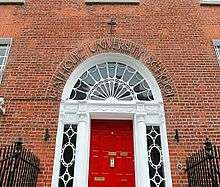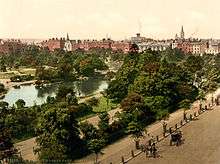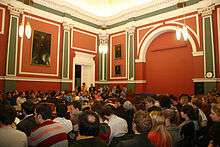Catholic University School
| Catholic University School SM | |
|---|---|
 | |
| Location | |
|
89 Lower Leeson Street, Dublin 2 Ireland | |
| Coordinates | 53°20′07″N 6°15′21″W / 53.335364°N 6.255966°WCoordinates: 53°20′07″N 6°15′21″W / 53.335364°N 6.255966°W |
| Information | |
| Type | Private school, Independent school |
| Religious affiliation(s) | Marist Fathers |
| Established | 1867 |
| Headmaster | Reverend Fr. Martin Daly SM MA, M.Sc. |
| Gender | Male |
| Number of students | 445 (2014/2015)[1] |
| Colour(s) | Blue and Red |
| Fees | €5,500 Per Academic Term |
| Former Pupils | Old Cathonians |
| Website | www.cus.ie |
Catholic University School (C.U.S.) is a private school for boys in Dublin, Ireland. The school was established by Cardinal John Henry Newman as a preparatory school for the Catholic University of Ireland.[2] It is one of the oldest private schools in Ireland which include Clongowes Wood College, 1814 and Belvedere College, 1832.
The school has educated Irish politicians and leading figures in the academic, literary, and business worlds. It is run by the Marist Fathers on Leeson Street.[3]

History
Origins
The foundation of the Catholic University School has its basis in the Catholic Revival movement of the late 1820s. For over 250 years, the only university in Ireland had been Trinity College, Dublin - the sole constituent college of the University of Dublin. However, although the University of Dublin had been opened to Catholics in 1793, only a few attended. Those Catholics who did were mainly educated in England at schools such as Stonyhurst College.[4]
In response to this issue, in 1850, Queen Victoria granted a Royal Charter founding three colleges of the Queen's University of Ireland. The colleges in Cork, Belfast and Galway were non-denominational. However, at the Synod of Thurles in 1850, the Catholic Church officially condemned these institutions as "Godless Colleges" and declared a need for a Catholic University.[5] Thus, the Catholic University of Ireland was founded in 1851 - though not fully established until 18 May 1854 with Cardinal John Henry Newman as its first Rector.
Early years
Dr Daniel Murray, the Archbishop of Dublin established a school at 16-17 Harcourt Street to ensure larger numbers of students for the new university and named the school after Saint Laurence O'Toole, the patron Saint of Dublin. St. Laurence's Academy, founded in 1850, was accompanied by the establishment of Belvedere College by the Jesuits in 1832 on the north side of the city.
The first administrators in the school were mostly young Dublin priests who had studied at the Irish College in Rome. Among them was Dr. James Quinn, who set about enrolling students from wealthy Catholic families. Within a year the school had an enrollment of 130 students. The subjects taught were classical rather than practical, reflecting the privileged composition of the school, and included Greek, Latin, French, German, Italian and the Arts. Pope Pius XI eventually chose Quinn as the first Roman Catholic Archbishop of Brisbane, Australia - and he left the school.
By 1862, many changes had taken place. Dr. Bartholomew Woodlock took over as rector of the Catholic University, and suggested that the university proceed with the foundation of feeder secondary schools on its own. Over time, St. Laurence's Academy developed a close relationship with the University. Woodlock was President of the school and professors from the University also taught in the school. The school was given a name reflecting its function: the Catholic University School.
Marist takeover
In the early 1860s, the finances of the School and University were intertwined, and the rent for the Harcourt Street premises was a high £2600 per annum. Neither the school nor the University were able to cope with this burden. Cullen was adamant that it was not possible for CUS to close down even for a year - because it would be possible that the school would never open again.

In 1867 both Cullen and Woodlock travelled to Dundalk for the consecration of Michael Kiernan as Archbishop of Armagh. While there, they visited the Marist College in Dundalk and were impressed with what they saw. Subsequently, Cullen and Dr. Conroy, his secretary, wrote to John Letterrier, father superior of Dundalk, and offered him and the Marists St. Laurence's Academy to take over. Letterrier brought the offer to the General Council of the Marist Fathers in Lyons in France. After a two-day petition, he convinced the Council of the benefit of taking on the Dublin school.
After Letterrier returned from Lyons in July 1867, Woodlock informed him of the financial burden the Harcourt Street premises had been. He recommended that the Marists purchase new premises, and when 89 Lower Leeson Street became available, the Marists purchased it. The Harcourt Street site remained on as the premises for the school for a short while, as work was required to prepare the Leeson Street building so it could be used as a school. On 29 September 1867 the Catholic University School opened on Lower Leeson Street.
Church historian and cleric Leo Chamberlain has suggested that the foundation of the school was an important development in education in Ireland.[6] Commenting on the form of education espoused by the school, Chamberlain describes the school as a Catholic Eton. He suggests that the schools aim was to provide an education to wealthy Catholic elites preparing them for University education with future leadership roles in mind.[7]
Admissions
Admission to Catholic University School is based on academic entrance exams as well as interviews of the boy and his parents by a member of the teaching staff and then by the Headmaster. Brothers of current or former pupils as well as sons of alumni are given preference for entry to the school. CUS offers a very limited number of scholarships and exhibitions for excellence in sport (Ronnie Delany scholarship) and academic work (Sarsfield-Hogan scholarship) to talented boys who wish to attend the school but can not afford to pay the fees.
Curriculum
The curriculum offered at the school is broad, covering all common subjects in the State Examinations including Classical Studies, Art History, German, Art, Chemistry, Physics, Accounting and Economics. Leaving Cert scores are very high, with over 70% of students scoring 510 points or more.[8] Catholic University School is placed in the top ten schools in Ireland with 100% of students accepting a place in Higher or Further Education.[9] CUS is also a feeder school for top Irish and international universities.[10] The pupil to teacher ratio is 9:1, which is low by general school standards. Class sizes start at around twenty in first year and are below ten for most senior cycle subjects. The Preparatory School offers the full Primary School Curriculum (Maths, English, Irish, S.E.S.E, Art, Music, Drama, S.P.H.E, Religion. P.E). In addition to the Curriculum the following subjects are also taught in the Primary School: Classics, Latin, Spanish and Mandarin.[11]
School traditions
Catholic University School has many traditions which both pupils and teachers continue to carry out to this day.
Traditional awards
- The Head's list awards pupils recognition in each year group for consistent hard work and effort throughout the year.
- Pupils who achieve excellence in a modern language are awarded the title of Sarsfield-Hogan Scholars and a Bursary towards the school fees.
- The Cusack cup is awarded each year to the student who gains the best results in the Junior Certificate exams.
School Songs
The school has a long musical history and this is displayed through the school song “Walking On” which is sometimes heard at school rugby matches, and other celebratory school events. The primary religious anthem of the school in recent years has been Dominican Magnificat, taken from The Magnificat passage in The Gospel of Luke.
Other school traditions and cultures
Religious traditions of the school include weekly services in the school Oratory and annual services for deceased past pupils. The school also has a long-standing connection to SVP and holds an annual "hamper fund" in order to raise funds to the charity. In line with the schools charitable outlook, each year students travel to Davao in the Philippines where they teach English to the homeless, and also help with the various Marist Missions.[12]
Houses
Historically, the school was divided into three houses; Colin, Sarsfield, and Hogan.[13] Students were accepted into a house upon admission to the school and placed under the supervision of a housemaster, usually a clerical member of the teaching staff. Different colours and patterns on students ties identified them as members of their respective houses. This house system remained in use in the early 20th century.[14]
School facilities

Catholic University School is located near St. Stephen's Green in Dublin. The Georgian buildings to the front of the school are home to an extensive Georgian library, debating chamber, and other formal function rooms as well as the school Oratory and Headmasters residence. The old buildings of the school include a great hall decorated in the Victorian style, a sports hall with a modern underground gym and changing rooms and the "old school" building, a Victorian building home to the English, Classics and History departments of the school. CUS also houses 2 modern buildings constructed around 2008. These buildings contain several classrooms, 3 science laboratories and 2 state of the art computer rooms. The new buildings also house the school's new modern restaurant. The school also owns a large area of land in Milltown, Co. Dublin, this is home to the school's 4 rugby pitches and cricket field as well as the sports pavilion. In 2013 the old pavilion was demolished and replaced with a new modern building. This 1.5 million Euro development was completed in September 2013. CUS also leases tennis courts and swimming pool facilities near-by in Ballsbridge
Renovation
Starting in 1990 the school began a large renovation project which resulted in the construction of several new buildings at an estimated cost of over 4 million Euro. The Georgian buildings at the front of the school have also recently undergone restoration work.[15]
Sports
The school has a long association as a rugby school, with students released on Wednesday afternoons to participate in sports. Rugby and cricket take place in Bird Avenue, Milltown. The school plays Cricket from Easter on. CUS is regarded as one of the dominant cricket schools in Leinster and Ireland. Other sports played during summer half include Golf, Badminton, Tennis, Squash and Athletics. All sports are under the jurisdiction of the school games-master responsible for the organisation of all sporting activity within the school. Olympic gold medal winner Ronald Delany is a past pupil.
Prefects
In addition to the teachers, a limited number of senior boys are entitled to exercise School discipline. Boys who belong to any of these categories, in addition to a limited number of other boy office holders, are entitled to wear a distinctive form of the school jumper with a prefects badge or crest. Sixth Year Prefects are a prefectorial group consisting, by custom, of 15 senior students selected by the Headmaster upon recommendations.[16] These recommendations are made by teachers based on an interview the students elect to undertake the previous term. Sixth year prefects maintain dress code regulations and perform Speeches at formal events held during the year.
Literary and Debating Society

Catholic University School is one of the dominant schools in debating with students winning prizes at a provincial and national level. The Literary and Debating Society has produced a variety of acclaimed debaters. Students have represented Ireland at The World Schools Debating Championship. Past pupils have also become prominent at university level with former members noted as figures in The Trinity College Historical and Philosophical societies, as well as UCD Literary and Historical Society.
The society is governed by senior students. The head of the society, The Auditor is assisted by the Convener. The school also actively encourages boys to take part in internal school debates and speeches with the junior L&D society playing an increasingly prominent role in school life. Literary excellence in students is rewarded with the Sebastian Barry award for English, a creative writing competition run by the English department.
CUS Past Pupils Union
Catholic University School Union is one of the oldest past pupils unions in Ireland.[17] The union is a forum for former pupils to gather for annual events such as the President's annual dinner, Christmas Lunch at the Stephens Green Hibernian Club or the Past vs Present pupils golf competition. Former union presidents include Sir Arthur Chance, Mr. Justice Richmond McLoughlin and businessman Niall O'Farrell.
Notable alumni
Academia
- Arthur Clery - Politician, university professor
- Robert Dudley Edwards - Professor, historian
- Joseph Mary Plunkett, Count Plunkett - Poet, scholar, and politician.
Government
- Frank Feely - Former Dublin City Manager
- Patrick Lynch (Irish Economist) - TD, former UCD Professor of Economics and Chairman of Aer Lingus
Politics
- John Dillon - Leader of the Irish Parliamentary Party
- Arthur Clery - Politician and university professor
- Seán "Dublin Bay" Loftus - Lord Mayor of Dublin
- John Boland - MP for South Kerry
- Peter Martin Joseph ffrench - Baron ffrench
Law, Medicine and Business
- Sir Arthur Chance - surgeon to the Viceroy
- Justice Richmond McLoughlin - High Court Judge
- Herbert V. Byrne M.D - Union President 1913-1914.
- Gerald Horan B.A. B.L., K.C - Barrister and King's Council
- Ron Delaney - Irish Olympic gold medal winner (athletics) and honorary Doctor of Law.
- John Pius Boland - Barrister, Master of the bench of Lincoln's inn and MP
- Martin Murphy - Managing Director of Hewlett-Packard Ireland.
Arts, Entertainment, and Literature
- Dave Allen - Author
- Sebastian Barry - Author and Academic
- Lucius O'Callaghan - Former director of the National Gallery of Ireland
- Joe Dowling - Artistic Director, Guthrie Theater, USA; former Artistic Director, Abbey Theater
- George Desmond Hodnett - Musician, songwriter and Irish Times music critic
- John Larchet - Composer, UCD's first Professor of Music (1921–1958)
- Graham Linehan - Writer, actor and director
- PJ McCall - writer
- George O'Neill - Academic, author
- Baz Ashmawy - Radio and television personality
Sports
- Eoin Morgan - England Cricket captain and former sports scholar of the school.
- John Pius Boland - first ever winner of Olympic gold medals for tennis and MP for South Kerry
- Ronald Delaney, LLD - Irish Olympic gold medal winner (athletics)
- Dean Rock - Gaelic footballer
Religious
- James Moriarty - Bishop Emeritus of the Diocese of Kildare and Leighlin
Notes
- ↑ "Data on Individual Schools - Department of Education and Skills". Education.ie. Retrieved October 30, 2016.
- ↑ Ciaran O'Neill, Catholics of Consequence: Transnational Education, Social Mobility, and the Irish Catholic Elite 1850-1900, (Oxford,2014), p.110.
- ↑ "Catholic University School". Retrieved 5 January 2015.
- ↑ Whittle, Sean, Newman and Contemporary Debates about Catholic Education, New Blackfriars, (2015), Vol. 96, pp.279-294.
- ↑ Cusack, M.F., The patriot's history of Ireland, Dublin, 1869, p.351.
- ↑ Chamberlain, Leo, A Catholic Eton Newman's Oratory School, Logos: A Journal of Catholic Thought & Culture. (2008), Vol. 11, pp.69-85.
- ↑ Chamberlain, Leo, A Catholic Eton Newman's Oratory School, Logos: A Journal of Catholic Thought & Culture. (2008), Vol. 11, p.80.
- ↑ "An Roinn Oideachais agus Scileanna" (PDF). Education.ie. 20 September 2010. Retrieved 30 October 2016.
- ↑ "About School League Tables". Schooldays.ie. Archived from the original on 29 October 2016. Retrieved 30 October 2016.
- ↑ Katherine Donnelly and Kevin Doyle (26 November 2013). "Fee-paying schools send most students to college - Herald.ie". Herald.ie. Retrieved 30 October 2016.
- ↑ Mark Keenan (30 October 2016). "Top marks: The schools that shaped our business brains - Independent.ie". Independent.ie. Retrieved 30 October 2016.
- ↑ "Catholic University School". Cus.ie. Retrieved 30 October 2016.
- ↑ C.U.S., 1967, p.57.
- ↑ C.U.S., 1967, p. 82.
- ↑ "George O'Malley Plastering". Omalleyplastering.com. Retrieved 30 October 2016.
- ↑ McConnell, pp. 57, 129-37
- ↑ "CUS Union". Retrieved 5 January 2015.
- ↑ "- CUS Union Past Presidents". Cusunion.ie. Retrieved 30 October 2016.
References
- C.U.S., 1867-1967; a Centenary Record, Catholic University School, 1967
- Henry, Dalton (1985). "Educating and Enlightening". Ireland's Elite. Dublin: MacMillan. ISBN 978-0-312-05726-8.
- O'Connor, Antony (2002). Young Dublin. Dublin: Viking-Penguin Books. ISBN 978-0-670-03041-5.